BISTROT BELHARA–The Extremely Discreet Charm of the Bourgeoisie at a Good New Left Bank Bistro, B+
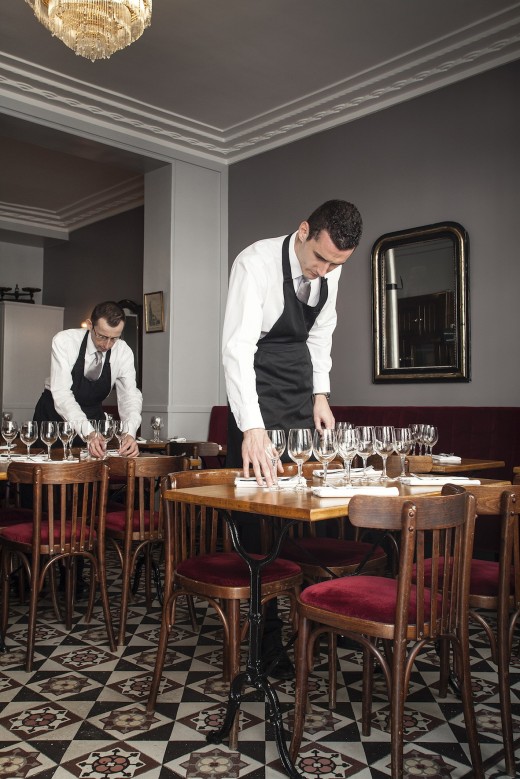 @stéphane bahic
@stéphane bahic
It’s hard for me to say exactly when my deep love of good food first surfaced, but suffice it to say that the thing that interested me most when our local newspaper arrived on Wednesdays were the school-lunch menus, which were published weekly so mothers could decide what days they’d pack a lunch for their kids or let eat the hot meal at school. My first school, the Greens Farms Elementary School, had a crew of smiling Italian ladies in hairnets who cooked everything from scratch, so the food was usually delicious. They made lasagna, spaghetti and meatballs, baked zitti, grilled Italian sausages with peppers, and lots of other hearty, healthy dishes, including corned beef and cabbage for Saint Patrick’s Day, and once when my mother ate with us in the cafeteria before an afternoon field trip to a nearby dairy farm, she got up at the end of the meal and went into the kitchen to thank the cooks. I’d returned to the rails for a spoon for my butterscotch pudding, and so witnessed the scene. Abashed by my mother’s thanks, one of the cooks replied, “You’re very welcome, Ma’am, but it’s a privilege to feed the children,” she said.
Similarly, I loved going to restaurants, which was an infrequent pleasure for me as a child, and not only because they offered an opportunity to eat things like egg rolls or fried clams (Howard Johnson’s) that Mom didn’t make at home, but because they were so interesting. I loved watching the people, catching snatches of other people’s conversations, observing all of the little dramas unfold all around the room–here a birthday party, there a quarrel or a romance. I couldn’t have expressed it this way then, but aside from the food, what I fascinated me was that every restaurant is like a little theater where you can glean a lot of information about where you are.
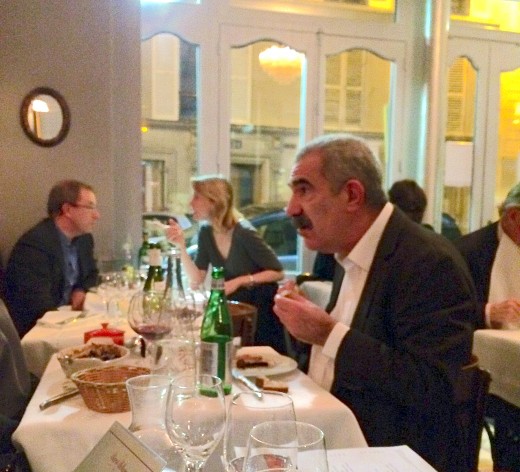
All of this came to mind the other night when I went to the Bistrot Belhara, a very good new bistro deep in the 7th arrondissement of Paris. I lived in the 7th arrondissement for many years, first on the rue Monsieur and then on the rue du Bac, and so I was sort of bemused to find the same cast of characters who populated my life for many years. While waiting for Bruno, I listened to the cashmere sweater drapped couple next to me planning a golf holiday in Mauritus, while the quartet to my right was fulminating about Francois Hollande. There were at least a half-dozen velvet covered Alice bands in the room and tight chignons galore. On a weekend night, the coat tree just inside the door was hung thick with loden, Barbours and vintage Burberry, as if many of those dining in this snug but handsome old-fashioned dining room with stenciled tile floors and bare wood tables were planning to head off to hunting parties in the Sologne after dinner. All told, the clientele presented such an intricate and irony-free tapestry of the habits, manners and preoccupations of the French bourgeoisie that it would have made great material for a sociological dissertation.
As I sipped a glass of white wine and studied the menu, I wondered what sort of gastronomic baseline chef Thierry Dufroux would chose to cater to such a crowd. On the one hand, he’s had a really distinguished career cooking in the kitchens of the Grand Hotel du Palais in Biarritz, Michel Guerard, Bernard Loiseau and Alain Ducasse in Monaco, and on the other, every chef surely has to do some sort of culinary calculus in terms of what’s likely to please customers from the neighborhood in which he or she has chosen to locate. To be sure, there are some addresses that will pull people from all over Paris if the food’s good enough, and which will ring bells in the foreign press, but before that happens, he or she is very much dependent pleasing the locals. And as I know not only from the dozens of Sunday lunchs to which I was invited to by the Englishman and his French wife who were one set of landlords while I lived in the 7th–I’ll still never forget my astonishment when I realized one warm May afternoon when their windows were tightly closed and the radiator in the dining room was still hissing that they were mutedly making an attempt at match-making between me and their shy sturdy scholarly daughter–and many years of living in the 7th, what makes these people happy is a penny-wise vieille France cuisine bourgeoise.
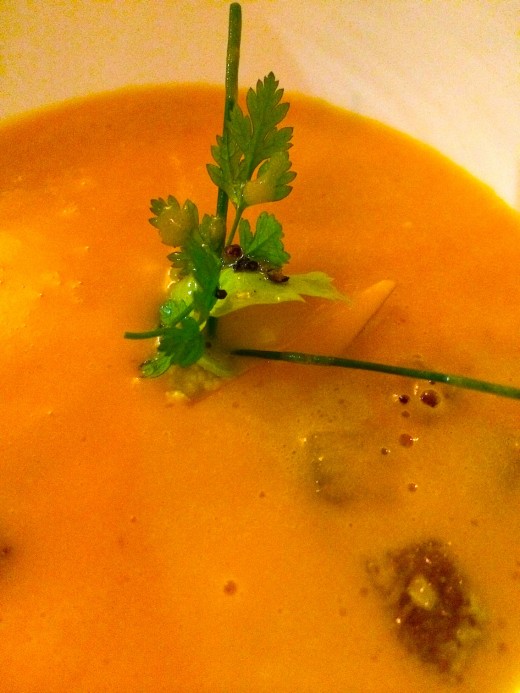
The menu read well, though, and the restaurant was packed, so I guessed we’d eat well. In the meantime, the cordial waiter answered a question I had even before I’d asked it when he told me that the restaurant’s Moroccan sounding name actually refers to a type of very tall wave in the Bay of Biscay off of Saint-Jean-de-Luz in the Basque Country, a reference that might seem obtuse until you’re reminded that the chef worked in the Basque country for years and that it might be very roughly transliterated into “High Tide.” Once Bruno finally arrived from the distant suburb of Paris where he’d currently working, we ordered, and a homey well-made amuse bouche of butternut squash soup with brousse de brebis (fresh ewe’s milk cheese) and croutons announced the beginning of a very good meal.
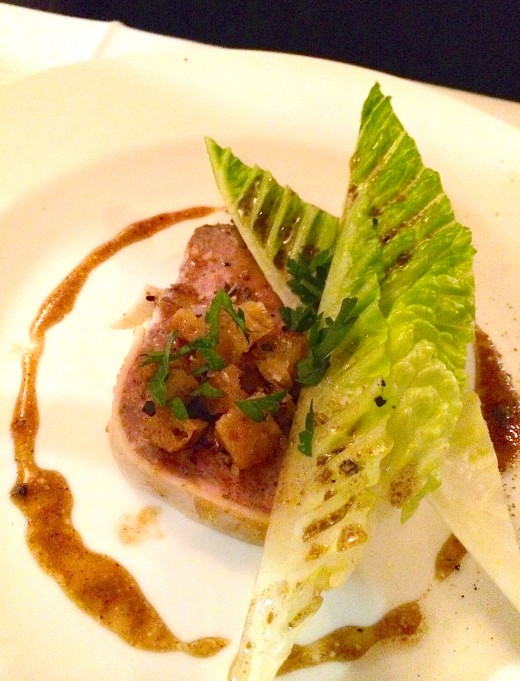
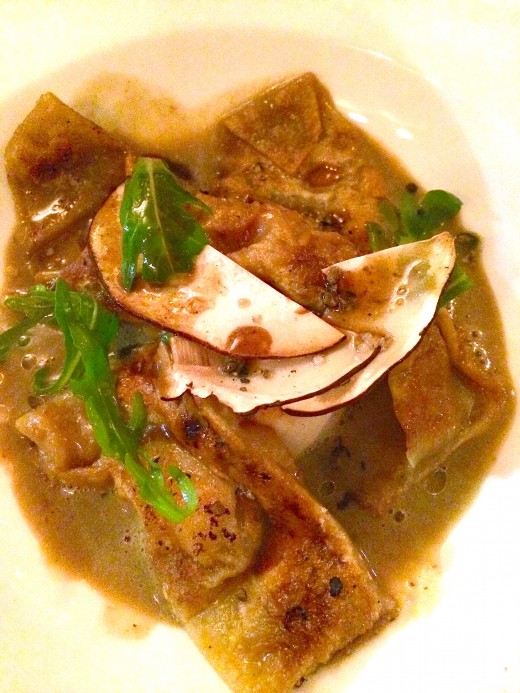
As part of the 38 Euro prix-fixe menu, Bruno’s terrine of pheasant and patridge with foie gras was beautifully made and had a politely feral and charmingly bosky flavor, with twin tridents of Romaine referencing the fact that Dufroux had done time with Ducasse. And in a similarly autumnal register, my scallop stuffed ravioli in a light veloute of cepes might have made a pious old maid blush with pleasure and was just the sort of dish that the locals would love, because they’d never get up to anything this elaborate in the kitchen themselves. This dish tipped the kitchen’s hand, too, since it tacked safely away from cooking that might jar conventional ideas of French gastronomy while heading squarely towards a welcome haven of technical perfection and generosity informed by a well-disciplined creativity and the use of excellent produce.
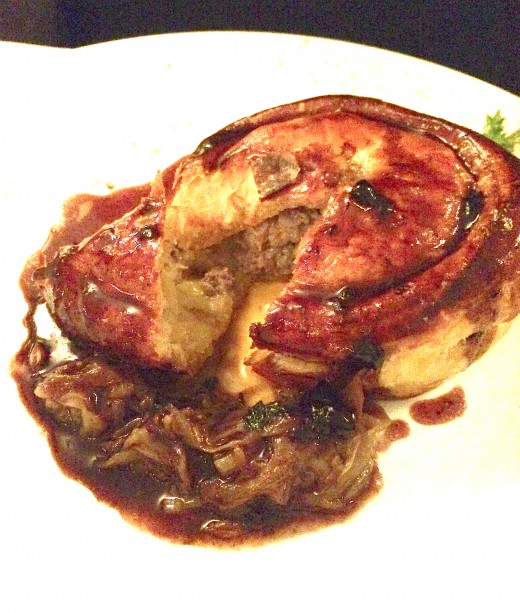
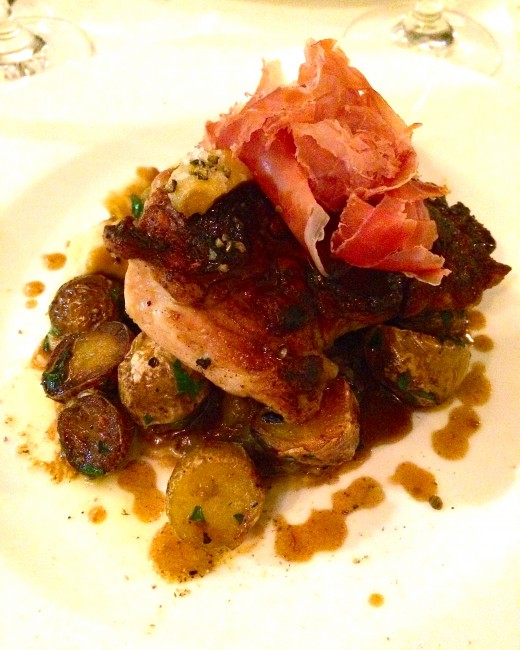
Our main courses were excellent, too. Bruno’s flaky golden petit pâté chaud was the type of exquisite dish that many of the other habituees of this restaurant that night might have enjoyed back in the sigh-inducingly long gone days when they could still afford full-time cooks, and it was filled with hashed duck and foie gras, one of the best pairings ever imagined in France. While Bruno was in a gamey mood that night, I couldn’t stay away from the escaloppe of veal sweetbreads, unctuously cooked to the texture of a nervy custard and garnished with baby potatoes and some Bayonne ham. In an inspired sleight of simplicity, the silky salty ham flattered the sweetbreads, and the appropriately unassuming sauce of deglazed pan drippings did what a sauce should do, which is meld the dish together. This preparation was perfect summary of Dufroux in the kitchen, too–casually elegant, technically perfect, and respectfully traditional with a tweak of irreverence to make it his own. Small wonder then that this restaurant has so impressively established itself as a neighborhood favorite within months of opening, and this while walking the tight-rope of an affluent but reflexively parsimonious clientele who are wary of anything that wanders too wide of the mark of traditional French food.
I don’t own a loden coat, and I’m not planning on buying one anytime soon either, but I really enjoyed this meal too, and not just for Dufroux’s cooking, but for the alert, gracious service and the fact that even though it’s not a bargain address, it’s remarkably good value for the money given the caliber of the cooking.
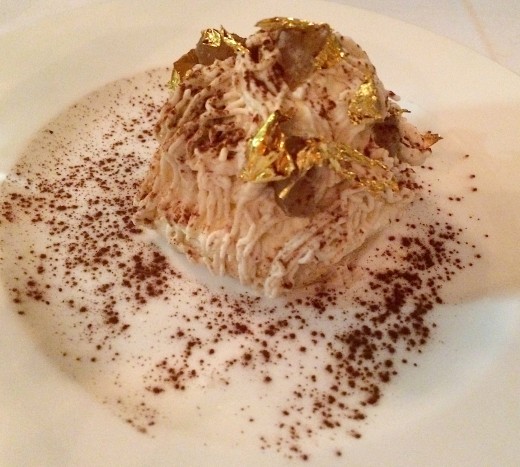
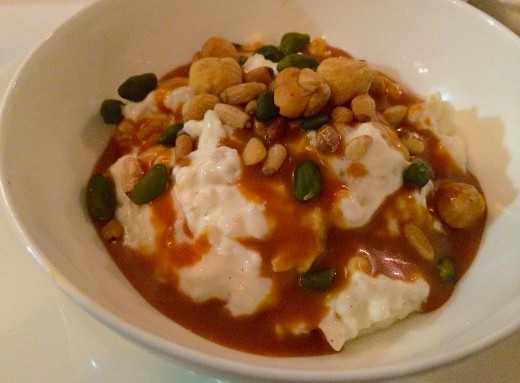
With no trace of being tongue-in-cheek, the grand finales of our meal were vieille France enough to make me chuckle. Bruno had a Mont Blanc–pureed sweetened chestnuts topped with whipped cream and little fluttering shreds of gold leaf, and I had a fluffy rice pudding with caramel sauce, raisins, hazelnuts, pine nuts and pistachios. So everything about this restaurant is sincere and wholesome, and it’s not only a good choice for a supremely French bistro meal with sly haute-cuisine credentials, but a fascinating place for some sociological sleuthing if you agree with me that there’s nothing better than a neighborhood restaurant in any city for an intriguing keyhole wide view or two of local life.
Bistrot Belhara, 23 rue Duvivier, 7th, Tel. 01-45-51-41-77. www.bistrotbelhara.com Metro: Ecole Militaire. Open Tuesday to Saturday for lunch and dinner. Closed Sunday and Monday. Prix-fixe 38 Euros. Average 40 Euros.




